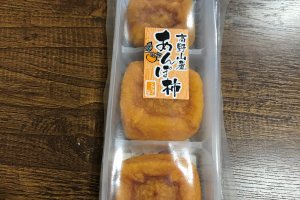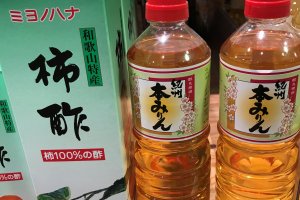Kudoyama Town at the base of famous Koyasan is not a common stopover point for visitors. Yet, there are some interesting places to discover, including the UNESCO-listed Jison-in Temple and nearby Niukanshobu-jinja Shrine.
Near Jison-in is also the starting point of the Choishimichi Pilgrimage trail that leads to the top of Koyasan. This 22-km long trail was the traditional way to get to Koyasan but nowadays not many visitors to the Buddhist mountain top monastery attempt this uphill walk.
These attractions were not the reason why we visited Kudoyama. We went there in search of unusual ways of eating persimmon, and we surely found them at the Kaki-no-Sato, the “Persimmon Village”, which was our eating place of choice. Previously we had tried Kakinoha-zushi at Kuwaraku, also in Kudoyama.
We met with Mr. Hiroshi Tamura from the Kudoyama Industry Promotion Council. He showed us around the Kaki-no-Sato and explained about Kudoyama’s marketing efforts for their fresh kaki fruits and kaki products.
Kaki is not kaki, Mr. Tamura explained. In nearby areas “Wakayama Kaki” or “Nara Kaki” are grown, but here the brand name is “Kudoyama Kaki”. Apparently the sticky soil in the Kudoyama area produces especially sweet varieties of kaki. Kudoyama Kaki are therefore mainly sold and eaten fresh. However, there are now also a number of interesting processed persimmon products.

Specialty of the house – Ampo-gaki
The local persimmon farmers are always on the lookout for new ways of marketing their delicious fruits. You might have heart about Hoshigaki, or dried persimmon, or about Kushigaki, dried persimmon on a skewer which is the specialty in Kushigaki Village in nearby Katsuragi Town.
The star in the persimmon offering here in Kudoyama, at the Kaki-no-Sato, is called Ampo Kaki. This is also is a kind of Hoshigaki, yet it has not been fully dried. In fact, it is half dry and half fresh, which makes for an interesting texture and taste. According to Mr. Tamura, Japanese people love Ampo Kaki and many visitors from Asian countries like them too and they buy many as souvenirs.
Ampo Kaki are made from Shibugaki, an astringent variety of kaki, as compared to Amagaki, the sweet variety of kaki that you can eat just like that.
Responsible for the astringent taste in Shibugaki is a high amount of tannin. Shibugaki needs to be sun-dried first, which breaks down the tannin in the fruits and turns them sweet and edible. The fully dried Shibugaki is then called Hoshigaki whereas the half-dried is called Anpo-gaki.



Processed kaki products
In comparison, the processed kaki products seem less interesting, but they are nonetheless worth checking out.
We also see kaki vinegar which has been in the kaki product range for 15 years already. Mr. Tamura explained that the usage of this kaki vinegar is similar to that of apple cider vinegar. Both types of vinegar may have some health-giving properties, such as a healthier cholesterol level and lower blood sugar. The price per bottle is with yen 1,400 or yen 3,000 a bit steep but considering the said healing properties, it might be worth the investment.
Then we have kaki narazuke, or pickled persimmon. Narazuke is a Japanese traditional way of pickling fruits and vegetables by putting them in lees, a sediment in the sake and mirin production process.
The kaki syrup is said to be very tasty on soymilk pudding.
There is also kaki dressing that can be used for salads.
Overall, there are not many processed kaki products in comparison to say the many processed apple products. The reason for this is that the apple taste remains strong even after heating and processing whereas the taste of kaki is weaker and soon lost when kaki is subjected to heat in the food processing process.

Persimmon bakery products
The bakery corner at Kaki-no-Sato serves tasty cakes and breads that contain persimmon. They looked irresistible to me, and they tasted just as good as they looked. For those who prefer bread over Kakinoha-zushi, this is the place to go in Kudoyama!


Persimmon Recipes
Even better, there is a whole booklet full of recipes for breads and cakes, for pizza and salads, and what not that all contain persimmon.
This coming autumn I am going to enjoy a kaki feast in all possible variations! Who wants to join me?

Last but not least: the"drunken kaki" of Kinokawa
If this is not enough of kaki lingo yet, then let’s take the Shibugaki talk one step further.
So, we can dry them to get Hoshigaki or half-dry them to get Ampo kaki. Yet, there is one more way to break down the tannin and turn Shibugaki edible, which is alcohol!
We were told that traditionally Shibugaki were put in a plastic bag after many holes were poked into the fruits. Then Shochu was added and the bag was put in the refrigerator for a few days. The alcohol speeds up the softening of the fruit’s flesh and makes it sweet.
In the Kinokawa area of Wakayama Prefecture this alcohol method has been taken to the next level to produce the “Kinokawa Kaki”, a new way of marketing the drunk persimmon.
Believe it or not, the Shibugaki fruit is soaked in alcohol while still hanging on the tree! Can you believe it! A bag that contains alcohol is put around the fruit for over 20 hours to take out the astringency. Then the alcohol bag is removed yet the fruit remains covered with a vinyl bag until the fruit is ripe and can be harvested.
Since this is a lot of work, the production volume of Kinokawa Kaki is small. Due to its rarity, these fruits fetch a high price. They are harvested in November, which would be the season to try and buy some. Good luck!






































